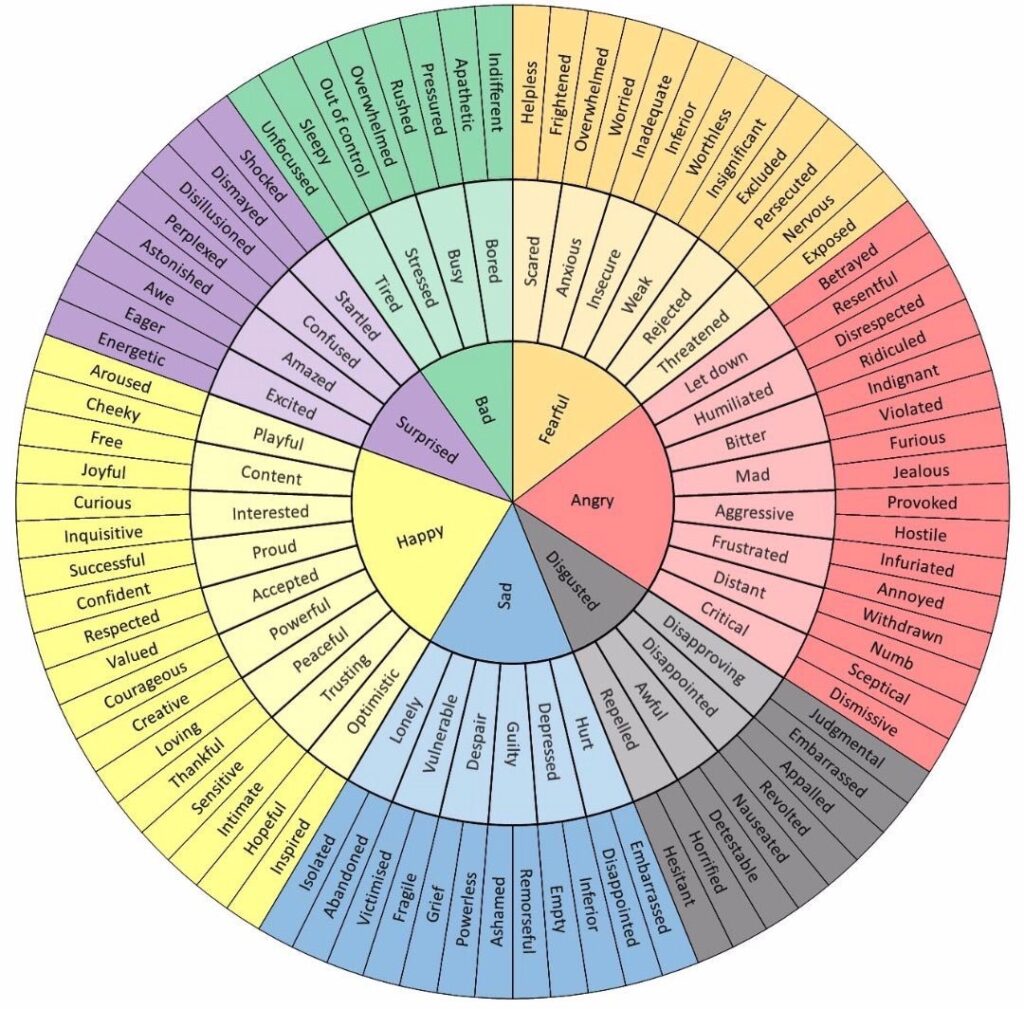
Touch and go – How to regulate uncomfortable emotions
One of the most common questions coaching clients ask me is how to regulate difficult emotions at work. This is indeed a complex question because there are underlying challenges that need to be brought to the forefront before tackling the answer:
a) Most people find it difficult to express emotions in the first place and have the limiting belief that communication at work should be focused on facts.
b) Instead of coping with uncomfortable emotions, we learn how to mask them, bottle them up, or numb them.
c) When you look at the wheel of emotions below, about two-thirds of all available expressions of feelings can be categorized as challenging (bad, sad, fearful, disgusted, or angry).
Given these challenges, what can you do to break with learned responses that do not promote a healthy or productive way to mitigate these unwelcomed emotions at work? Let’s start by looking at the wheel of feelings and acknowledge that the current common vocabulary to express the many variations of feelings at work is limited at best. When we utilize only those words that are in the inner or middle cycle, we are shortchanging ourselves. It is like painting a picture with only primary colors instead of utilizing the entire color wheel.

What I would like to do is invite you to choose an alternative perspective. Rather than labeling feelings as “good” or “bad”, how about embracing them as “rich” and serving a purpose? That is right, ALL feelings serve a purpose. They are indicators of your response to a certain situation. No more, no less. When you think of other indicators in your environment, e.g., a clock that indicates time, or a traffic light that indicates go or stop, how much power do you allow them to have over you? Hopefully very little.
Feelings are fleeting. They come and they go. I would like to share with you how I learned to regulate my feelings in a way that serves me. I call it my “touch-and-go approach”. With a little bit of practice, you too can learn to regulate your emotional responses when triggered. Here is how.
The touch-and-go approach to dealing with uncomfortable emotions:
- Pause for a moment and become the observer of what is going on within you. If you are physically in an office environment, I encourage you to find a spot where you can be alone. If possible, step outside and maybe take a walk around the building.
- Label your feeling. Grab the wheel of emotions and name the culprit in as much detail as possible. Work your way from the inside of the wheel to the outside of the wheel and get granular.
- Sit with it and accept the feeling for what it is and without judging yourself. There is a reason why you are responding in this particular way. An outside trigger has threatened your identity and you are coping the only way you know.
- Resist the temptation to act. At work, this appears to be the most common challenge. Especially if you feel wronged. Someone stepped on your toes, violated your values, threatened your position, embarrassed you, etc. The list is endless. Try not to fire back with a reactive e-mail or a verbal attack.
- Ground yourself. Meditate, breathe, sleep on it, whatever it takes for your nervous system to calm down in a healthy way. The emphasis here is on responding in a “healthy” way. Reaching for a drink or other substance is not a healthy response.
- Question the truth. Your emotional response was likely a reaction to how you interpreted a certain situation and the meaning you gave it. If you stripped that situation down to the truth and the actual facts, was it really that bad? Is there another way to interpret the situation?
- Lastly, choose a response that better serves you. If you are struggling with this step, I encourage you to become curious about yourself, your response, and what you have learned from it.
As long as you gain new insights, you are growing and building muscle memory in your nervous system which will lead to different responses in the long run. Eventually, you will be able to move through these seven steps quicker and it will become a touch-and-go response.
Coaching can be a great way to build this muscle memory faster as you gain a greater sense of self-awareness about your triggers and your responses. As a coach, I help professionals with mindful transformations so they can SOAR in all areas of their lives. SOAR (the acronym stands for the four phases Seek, Outline, Awake, and Relearn) is the name of my signature program. Contact me for more information at angela@belladonnacareercoach.com to learn more. I look forward to chatting with you.